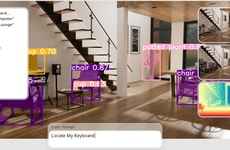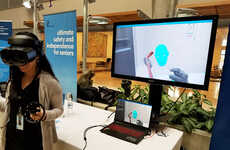
UPS is Now Using a VR Driving Simulator to Train New Drivers
Laura McQuarrie — August 22, 2017 — Tech
References: pressroom.ups & digitaltrends
Across all of its nine UPS Integrad training facilities in the United States, UPS is implementing a VR driving simulator that will become a routine part of driver safety training. These virtual reality modules will replace the touchscreen devices that are currently in use by the facilities, offering a more immersive experience.
The VR training system involves a wheel and stations a new UPS driver inside of a delivery van for an experience that challenges them to spot and avoid potential hazards. As UPS' chief information and engineering officer Juan Perez says: "VR creates a hyper-realistic streetscape that will dazzle even the youngest of our drivers whose previous exposure to the technology was through video games."
Virtual reality training is now being used across multiple industries, providing new employees with a safe environment in which to make mistakes and learn new tasks at their own pace.
The VR training system involves a wheel and stations a new UPS driver inside of a delivery van for an experience that challenges them to spot and avoid potential hazards. As UPS' chief information and engineering officer Juan Perez says: "VR creates a hyper-realistic streetscape that will dazzle even the youngest of our drivers whose previous exposure to the technology was through video games."
Virtual reality training is now being used across multiple industries, providing new employees with a safe environment in which to make mistakes and learn new tasks at their own pace.
Trend Themes
1. Virtual-reality Training - The rise of virtual reality training across multiple industries is presenting opportunities for companies to enhance employee training and productivity through immersive and safe learning experiences.
2. Simulation Technology - The use of simulation technology such as VR driving simulators presents opportunities for companies to improve safety training and reduce accidents, while also lowering costs associated with real-world training exercises.
3. Immersive Learning Experiences - The use of immersive technologies such as VR is creating opportunities for companies to improve learning experiences by creating more engaging, interactive, and realistic training scenarios.
Industry Implications
1. Logistics and Shipping - The use of VR driving simulators in UPS's driver safety training program is creating opportunities for logistics and shipping companies to improve driver safety and reduce accidents, while also improving training efficiency and reducing costs.
2. Automotive Manufacturing - The use of VR and other simulation technologies in automotive manufacturing is creating opportunities for companies to improve worker safety and reduce accidents, while also enhancing training and productivity by providing employees with realistic and immersive learning experiences.
3. Construction and Heavy Equipment - The use of simulation technologies such as VR in construction and heavy equipment training is providing opportunities for companies to improve worker safety and efficiency by creating realistic and safe learning environments that minimize the risk of accidents and injuries.
2.8
Score
Popularity
Activity
Freshness















